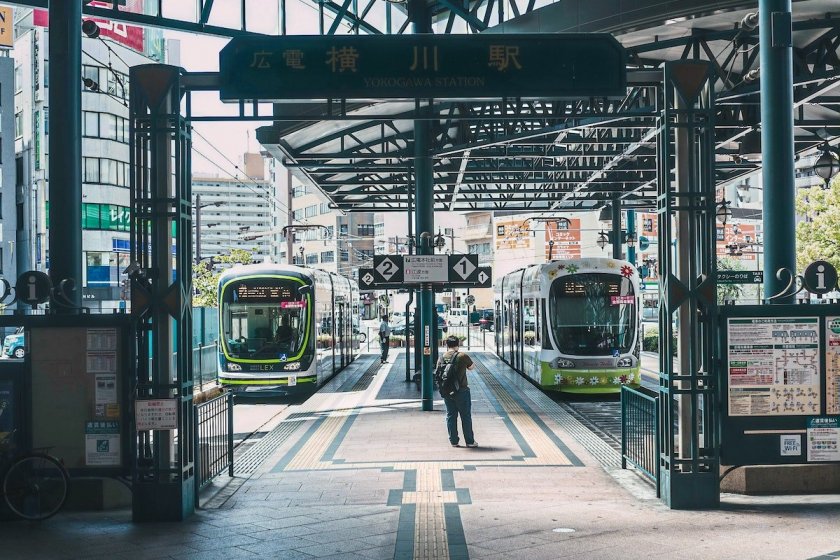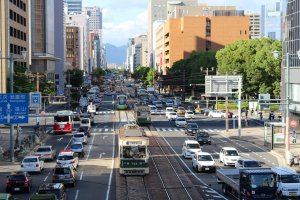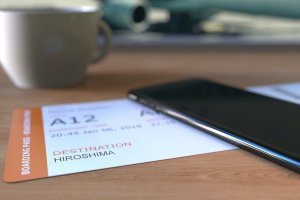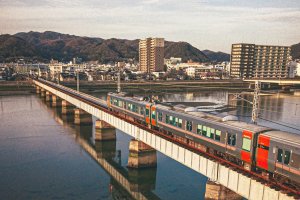Our Hiroshima access guide covers the basics of finding your way to Hiroshima prefecture via your chosen route of transport.
Get your bearings, find out how much time you'll need to reach certain destinations and figure out the best ways to get around Hiroshima's capital city and surrounding region in our in-depth look at Hiroshima's transport.
Orientation
Where is Hiroshima?
Hiroshima is located towards the western end of Japan's Honshu island:
Hiroshima is a popular extension to the main Golden Route of Tokyo and Kyoto, with many visitors arriving by bullet train direct from Himeji (1 hr) or Osaka (1 hr 30 min) to the east.
Hiroshima City is where most of the prefecture's sightseeing attractions are located, with the coastal Miyajima an easy 30-minute train journey along the coast to reach the mainland ferry terminal.
Onomichi is another well-known stop in the east of the prefecture, renowned for its ramen, mountaintop views and being the starting point for the Shimanami Kaido — a 60 km cycling route that connects Honshu to Shikoku via the Seto Inland Sea.
Getting to Hiroshima
By plane
Hiroshima Airport serves both domestic flights (Tokyo among others) as well as international routes via Singapore, South Korea, Taiwan and China. The airport is located in Mihara to the east of the prefecture and is best reached via limousine bus from the central Hiroshima Bus Centre (SOGO), which takes about 55 minutes.

By bullet train (shinkansen)
Hiroshima Station is a major stop for the Shinkansen along the Sanyo-Shinkansen Line (i.e. including Nozomi express services) which connects Fukuoka to Osaka. It's 1 hour 30 minutes from Osaka, or for those coming further, a direct 4 hour ride from Tokyo.

Local lines
It's entirely possible to reach Hiroshima by local train lines from wherever you're travelling from. Take into account you won't necessarily be able to reserve seating and may experience peak travel if during rush hour. On the other hand, you may find it lucrative to use local trains by taking advantage of the Seishun 18 ticket.

By ferry
Hiroshima can be reached via Shikoku's Ehime prefecture, with ferries operating a direct route via Matsuyama. Both Setonaikai Kisen and Ishizaki Kisen operate car ferries and faster Super Jet services — both running about once per hour:
- Super Jet services alternate between direct services and those that stop halfway at Kure. As of August 2025, a one-way ticket between Hiroshima and Matsuyama is 8,800 yen per person, with elementary school children half price. The full direct journey takes 1h10m or 1h20m via Kure.
- Car ferry services between Matsuyama and Hiroshima typically stop at Kure Port. As of April 2023, a one-way ticket between Hiroshima and Matsuyama is 5,800 yen per person, with elementary school children half price. The price for any vehicle depends on its classification, length and width, with reservations recommended. The full journey takes 2h40m.
Getting around Hiroshima
By tram/streetcar
Hiroshima City is known for its tram network which still runs today. Being built on a delta, Hiroshima resisted the move to a subway system like other Japanese cities and has kept its own Hiroden tram, or streetcar, network running efficiently to the present day. Dubbed the 'Moving Museum,' this cheap and convenient transport network still uses earlier models from the 1950s alongside newer ones. There are 7 main lines that criss-cross Hiroshima City and a simple flat fare of 240 yen (120 yen for children) covers your journey.

By ferry

Miyajima island can be reached via ferry in several ways:
- JR West Miyajima Ferry & Miyajima Matsudai Ferry:
The local ferry port at the mainland at Miyajimaguchi (which connects to JR trains and the tram) serves two separate ferry operators but they essentially work the same. The ride lasts 10 minutes and the fee is 200 yen each way (plus visitor tax). Ferries for both depart at 10-minute intervals, about 5-minutes apart from the other operator.- The JR West ferry is free for JR Pass holders.
- Matsudai offer a ticket option that includes a round-trip on the Miyajima Ropeway.
- Aquanet:
This Miyajima-bound ferry departs from Motoyasu Pier on the eastern side of the Peace Park. It's a 45-minute journey with 2-3 services available each hour. It costs 2,200 yen (4,000 yen round-trip) for adults, with children about half-price. Round-trip journeys are valid over two days, useful if staying on the island overnight. This World Heritage Sea Route can be affected via tide conditions. Aquanet also offer a light-up cruise near Itsukushima Shrine's Otorii gate in the evenings. - Setouchi Sea Line:
A direct ferry service to/from Hiroshima Port (including neabry Hiroshima Prince Hotel) is also available. It takes about 30min and costs ¥2,300 (single) or ¥4,400 (round-trip), with child fares half-price.

To reach the mainland ferry port, you can either take a JR train to Miyajimaguchi Station or the local Hiroden tram service (#2). The JR local train (Sanyo Line) takes about 30 minutes from Hiroshima Station and costs 420 yen, but is covered by the JR Pass. The 240-yen tram takes up to an hour along the full route from Hiroshima Station, but can be convenient (and a shorter journey) if you are already staying in the downtown area.
From the station, it's a short walk to the ferry terminal.
If taking the tram, consider Hiroden's 1 Day Streetcar and Ferry Pass, which includes the Matsudai ferry service (but not JR!).
By bus
Hiroshima is well served by a network of buses that cover most of the city and can get you to Hiroshima Station and downtown in record time.
If you focusing on Hiroshima's tourist attractions and want to minimise walking, the Meipuru-pu sightseeing loop bus is also a viable option which connects Hiroshima Station with the main sightseeing spots across 4 different colored routes. A day pass costs 400 yen (200 yen kids) but single journeys are also possible. Bus services include access to Hiroshima Free Wi-Fi.

Hiroshima Bus Center is located on the third floor of Sogo Department Store, which provides express bus services that connect to the rest of the prefecture, including Hiroshima Airport.
By bicycle
With its many rivers flowing through the city, Hiroshima City almost feels designed for cyclists.
Take advantage of Docomo's extensive share bike network (Peacecle) in Hiroshima City, or consider e-bikes and e-scooters from Luup (over 150 ports are available). Learn more about Luup.
If you are visiting Onomichi to prepare for your Shimanami Kaido ride, don't miss Onomichi U2. Opened in 2014, this renovated warehouse facility is now home to a hotel, cafe, bakery, restaurant and shops—complete with all the cycling gear you could possibly need. A number of local outlets offer bicycle rentals for both the local city area, as well as those looking to ride the Shimanami Kaido itself.

Astram Line
The Astram line is a rapid transit system originally built for the 1994 Asian Games, held in Hiroshima. It connects the downtown Hondori area to Kōiki-kōen-mae to the north-west, where the multi-purpose stadium of Hiroshima Big Arch is located.
Riding the Astram Line from Hondori and alighting at Johoku can provide an alternative approach to Hiroshima Castle.

Transport passes
| Visit Hiroshima Tourist Pass | This pass gives you unlimited access to Hiroshima's transport network for 1, 2 or 3 days, starting from 1000 yen. |
|---|---|
| One Day Streetcar and Ferry Pass | Hiroden offer a one-day streetcar pass which includes Matsudai ferry access for ¥900 (¥450 kids). |
| 1 Day Streetcar Pass | Hiroden offer a pass without ferry access if you know you're not heading to Miyajima. It's ¥700 (¥350 kids). |





































